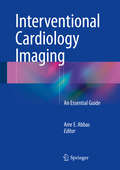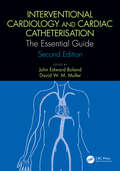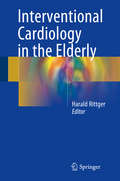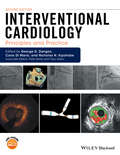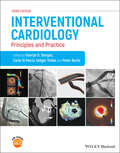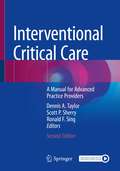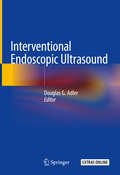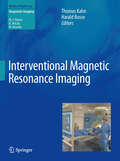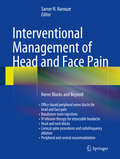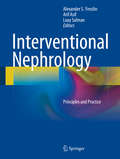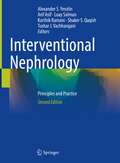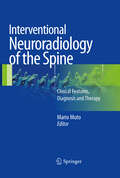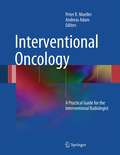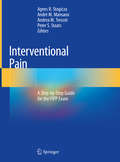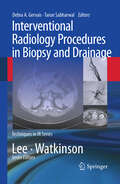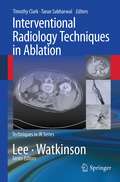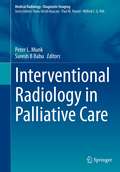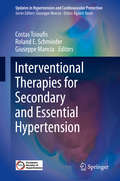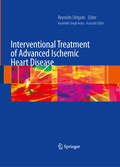- Table View
- List View
Interventional Cardiology Imaging
by Amr E. AbbasInterventional cardiology has transitioned from angiographic subjective analysis of stenosis severity into assessment of plaque characteristics and objective assessment of stenosis severity. The evolution of novel interventional imaging modalities is progressively altering our understanding of coronary artery disease diagnosis and prognosis. This book will be an essential companion to assist interventional cardiologists in better assessing patients with Coronary Artery Disease. It will encompass and review all interventional imaging modalities and provide guidance for interventional cardiologists to use these modalities.
Interventional Cardiology and Cardiac Catheterisation: The Essential Guide, Second Edition
by John Edward Boland David W. MullerCardiology is becoming an increasingly complex field understood by only a select group of medical specialists. This publication demystifies many difficult topics in interventional cardiology and cardiac catheterisation, commencing with the basics of laboratory instrumentation and technology and progressing to a comprehensive review of both new and established cardiac interventions. <P><P> Unlike other publications that are directed mainly towards clinicians, this text is specifically written to assist newcomers such as such as medical trainees, nurses, technicians, scientific staff and other allied health professionals understand the wonders of interventional cardiology, and includes extensive explanations of the techniques of angiography, and new percutaneous. <P><P> The comprehensive information presented herein, written by recognised specialists in their respective fields, will no doubt prove of great benefit to clinician and non-medical specialist alike.
Interventional Cardiology in the Elderly
by Harald RittgerThis book provides an in depth review of the current practice in treating elderly patients with coronary artery disease (CAD) as well as an update of the existing literature. It is intended to reflect the current science of elderly patients with stable angina, acute coronary syndromes and those patients who are forwarded for CAGB procedures. Evidence in the elderly patient group is often limited and/or non-existent therefore the main challenge, even for further research, will be to define the role of geriatric preconditions and its impact on outcome. A second topic will be to clarify how, if ever, existing cardiological outcome values like mortality can be applied to elderly patients or if other values like improvement of functional status or quality of life are more suitable parameters to measure interventional success in elderly patients. The role of pharmacotherapy in advanced age has to be discussed. These topics will be embedded in epidemiological, pathophysiological and ethical aspects of interventional treatment of CAD in older age.
Interventional Cardiology: Principles and Practice
by Carlo Di Mario Peter Barlis George D. Dangas Nicholas N. Kipshidze Tayo AddoExpert guidance from internationally recognized authorities, who provide clear and current updates on all aspects of interventional cardiology. This new edition; Contains a radically expanded chapter contents list presented in four clear sections; coronary interventions, interventional pharmacology, structural heart interventions, and endovascular therapy Includes 46 new chapters, including the latest advances in bioresorbable coronary stents, advanced transcatheter aortic valve replacement, MitraClip, new transcatheter mitral valve interventions, and more Chapters are templated for rapid referral, beginning with pathophysiological background and relevant pathology, moving to mechanisms of treatment, device description, procedural techniques, follow-up care, and ending with risks, contraindications and complications Multiple choice questions at the end of each chapter for self-assessment, a total of more than 400 MCQs in the book Features 19 procedural videos, hosted on a companion website
Interventional Cardiology: Principles and Practice
by Carlo Di Mario Peter Barlis George D. Dangas Holger ThieleINTERVENTIONAL CARDIOLOGY The updated guide to understanding and implementing today’s interventional cardiology procedures Minimally invasive methods of cardiovascular intervention are developing apace, propelled by unprecedented advancements in technology and procedural expertise. Bearing exciting implications for a broad range of adjacent fields of surgery and patient care, these innovative techniques are of ever-increasing importance, not only within cardiology, but across medicine as a whole. This third edition of Interventional Cardiology is designed to equip practitioners of all levels with a working knowledge of today’s best and most up-to-date practices, as well as the fundamental principles that underlie their use. Expertly revised to span coronary interventions, interventional pharmacology, structural heart interventions, endovascular therapy, and more, its modular sections are accompanied by multiple-choice questions to help aid learning and self-assessment. The new edition of Interventional Cardiology features: A thorough survey of the field, including atherogenesis and inflammation, vascular access controversies, radiation protection concepts, acute and chronic interventional pharmacology recommendations for high risk subjects/procedures Evaluations with imaging and physiology, including physiologic assessment in the cardiac catheterization lab, intravascular ultrasound, and optical coherence tomography Discussions of revascularization in various clinical settings, including stable coronary heart disease, acute myocardial infarction, he management of cardiogenic shock, and hemodynamic support devices and techniques Examinations of coronary interventions in various lesion types, including complex lesions, left main, bifurcations, CTO Heart valve disease and relevant percutaneous interventions, including preop imaging and clinical evaluations and outcomes assessment in great depth and with technical details; left atrial interventions are an expanding frontier Peripheral vascular, carotid and aorta/branch diseases are covered in greater detail than previous editions; venous disease treatments have become well established Accompanied by a companion website featuring videos illustrating key procedures and interactive multiple choice questions Whether studying for certification or already working in advanced practice, medical professionals of all kinds will benefit greatly from the practical instruction and cutting-edge knowledge found within this vital third edition.
Interventional Critical Care
by Dennis A. Taylor Scott P. Sherry Ronald F. SingThis book provides a comprehensive, state-of-the art review of the interventional procedures that can be performed in intensive care settings. The book addresses fundamentals of the indications and technical aspects of procedures, and identifies pitfalls and resource needs. In addition, a section is dedicated to a discussion of the staff-preparation, hemodynamic, and anesthetic concerns necessary for all procedures. Chapters focus on the following specific concerns: airway, thoracic, ENT, vascular, abdominal, genitourinary, neurologic, and musculoskeletal. A brief review of the existing literature addressing these particular topics accompanies each section. Extensive illustrations and diagrams are also included to enhance the readers' experience. Authored by a multi-disciplinary team of experts in their fields, Interventional Critical Care: A Manual for Advanced Care Practitioners serves as a comprehensive resource for advanced care practitioners and physicians for performing and preparing for procedures in the ICU.
Interventional Critical Care: A Manual for Advanced Practice Providers
by Dennis A. Taylor Scott P. Sherry Ronald F. SingThe goal of the first edition of Interventional Critical Care: A Manual for Advanced Care Practitioners was to fill a knowledge gap of the advanced practice provider (APP) specifically regarding the skills and understanding of critical care procedures in response to the rapidly expanding participation of APPs in critical care. Written by experts in the field, this successor edition adds to the content of the first by expanding upon ultrasonography areas to include more direct hemodynamic evaluations as well as the newer “e”FAST. It also explores the specialty of Urology to include more complex interventions. As billing and coding are necessary, the authors added appropriate CPT codes for each of the appropriate chapters. Most chapters have been completely re-written and updated from the first edition and have different authors – thereby a different perspective and experience level. Interventional Critical Care 2nd Edition serves as a valuable reference for physicians and advanced practice providers in daily practice in the ICU, OR and/or ED setting.
Interventional Endoscopic Ultrasound
by Douglas G. Adler, MD, FACG, AGAF, FASGEThis volume provides a comprehensive, state-of-the-art overview on interventional endoscopic ultrasound (EUS). Each chapter covers a single procedure or related group of procedures, features a detailed literature evaluation and tips on these cutting edge endoscopic techniques, and is accompanied by a comprehensive endoscopic video and illustrative endoscopic and ultrasonographic images. The text also reviews adverse events related to interventional EUS, both how to avoid them and how to manage them when they arise. Written by to endoscopic experts in the field, Interventional Endoscopic Ultrasound is a valuable resource for practicing gastroenterologists who perform advanced endoscopy.
Interventional Magnetic Resonance Imaging
by Harald Busse Thomas KahnThe idea of using the enormous potential of magnetic resonance imaging (MRI) not only for diagnostic but also for interventional purposes may seem obvious, but it took major efforts by engineers, physicists, and clinicians to come up with dedicated interventional techniques and scanners, and improvements are still ongoing. Since the inception of interventional MRI in the mid-1990s, the numbers of settings, techniques, and clinical applications have increased dramatically. This state of the art book covers all aspects of interventional MRI. The more technical contributions offer an overview of the fundamental ideas and concepts and present the available instrumentation. The richly illustrated clinical contributions, ranging from MRI-guided biopsies to completely MRI-controlled therapies in various body regions, provide detailed information on established and emerging applications and identify future trends and challenges.
Interventional Management of Head and Face Pain
by Samer N. NarouzeFrom the Foreword, by Stewart J. Tepper, MD: "Dr. Samer Narouze was the first Pain Management anesthesiologist specialist in the US to become Board-certified in Headache Medicine by the United Council of Neurologic Subspecialists (UCNS). It is therefore fitting that he decided to put together a textbook on blocks, interventions, injections, and neuromodulation possibilities in this integrated interdisciplinary area of treatment for head and facial pain. . . "This constellation of authors and topics should offer a comprehensive roadmap for interventions to contemplate beyond conventional medications in both primary and secondary head and face pain disorders. The chapters are precise, concise, and immensely readable, and I am honored to have been offered the chance to introduce them and encourage my colleagues to read them. " This is the first book on interventional management of intractable, medically resistant head and face pain It is edited and written by world-class leaders in headache medicine and features practical presentations of the entire spectrum of procedures, from simple to complex Designed to help shorten the learning curve of practitioners who are beginning to use interventional headache procedures, it provides guidance in identifying patients who are appropriate candidates for this approach and includes a unique compilation of outcomes-based algorithms for different headache and face pain syndromes. Neurologists, anesthesiologists, pain physicians, physiatrists, neurosurgeons, and interventional radiologists are the intended audience.
Interventional Nephrology
by Alexander S. Yevzlin Arif Asif Loay SalmanInterventional Nephrology: Principles and Practice describes a very direct approach to clinical problems encountered by the community of care providers who treat chronic kidney disease and dialysis patients. Practical scenarios faced on a day-to-day basis are presented by experts in the field utilizing the latest scientific information. In addition to internal medicine residents, nephrology fellows and practitioners, this comprehensive and useful resource is a must-have for the allied health professionals taking care of patients with hemodialysis and peritoneal dialysis access problems.
Interventional Nephrology: Principles and Practice
by Alexander S. Yevzlin Arif Asif Loay Salman Karthik Ramani Shaker S. Qaqish Tushar J. VachharajaniThis book provides a comprehensive, state-of-the-art overview of interventional nephrology. Similar to the previous edition, this text describes a direct approach to clinical problems encountered by the community of care providers who treat chronic kidney disease and dialysis patients. Practical scenarios faced on a day-to-day basis are presented by experts in the field, utilizing the latest scientific information. The book also features updated therapeutic guidelines and fully revised and new chapters.Written by the foremost authorities in the field, Interventional Nephrology: Principles and Practice, Second Edition is a must-have resource for clinicians and practitioners who treat and manage patients with hemodialysis and peritoneal dialysis access problems.
Interventional Neuroradiology
by Kieran Murphy Fergus RobertsonInterventional radiology has seen a dramatic increase in the number of minimally invasive therapies performed. Interventional radiology treatments now play a major role in many disease processes and continues to grow with new procedures added to the armamentarium of the interventional radiologist, almost on a yearly basis. There are many textbooks which are disease specific, which incorporate interventional radiology techniques. These books are important to understand the natural history, epidemiology, pathophysiology and diagnosis of disease processes. However, a detailed handbook that describes the technique of performing the various interventional radiology procedures is a useful addition to have in the Cath Lab, where information can be accessed easily before, during or even after a case. This technique-specific book is primarily of benefit to those in training in general radiology and more specifically for Residents and Fellows who are training in interventional radiology and who may be taking subspeciality certificate examinations in interventional radiology. In addition, this book will be of help to most practicing interventional radiologists, be they be in academic or private practice. This is the kind of book that can be left in the interventional lab and will be of benefit to ancillary staff, such as technicians/radiographers or nurses who are specialising in the care of patients referred to interventional radiology. This volume on neurointervention will enhance the series by expounding on the specific techniques required when working on conditions of the head, neck and spine.
Interventional Neuroradiology of the Spine
by Mario MutoAccurate interpretation of indications for treatment is the cornerstone of success in medicine. This book carefully examines the relation between clinical features, diagnosis, and choice of minimally invasive technique for a range of spine pathologies. It explains how selection of technique is intimately related to clinical and diagnostic aspects and how recognition of this relation forms the foundation for an optimal outcome. In addition to examining the various minimally invasive options, including the latest techniques, careful attention is paid to the role of medical treatment in avoiding recurrence after initial therapy. Nerve blocks, epidural injections, and intradiscal procedures are among the many options available in the armamentarium of the interventionalist, and advice is given on their use in different contexts. This volume will be of great value for neuroradiologists and others responsible for treating patients with spine disorders.
Interventional Oncology
by Andreas Adam Peter MuellerInterventional Oncology is a fast-growing new field, as well as an emerging specialty. Many minimally-invasive, imaging-guided procedures seem set to replace more traditional open surgical techniques of treating solid tumors in a variety of organs. The aim of this book is to describe new interventional radiological methods in a succinct and practical form. Diagnostic radiological considerations relevant to the selection and follow-up of patients are also covered. The book begins with an overview of the basic principles of current interventional techniques, including thermal ablation, high intensity focused ultrasound, and embolization. Later chapters focus on tumors of the liver, kidney, lung, and bone, placing new interventional techniques in context by referring to the surgical and oncologic methods of treating the same conditions. With an emphasis on best practices, Interventional Oncology: A Practical Guide for the Interventional Radiologist will serve as a definitive guide to practicing physicians involved in this rapidly evolving field.
Interventional Oncology
by Jean-Francois H. Geschwind Michael C. SoulenInterventional oncology has joined surgical, radiation, and medical oncology as the fourth pillar of cancer care. Advances in imaging and image guidance for the detection, characterization, targeting, and therapy of cancer now allow for minimally invasive image-guided treatment of many solid tumors without the morbidity of open surgery or the toxicity of chemotherapy and radiation. The editors have brought together the accrued experience of pioneers and leaders in image-guided cancer therapy from around the globe to create the first comprehensive text for this emerging field. Covering the biology, techniques, clinical applications, and outcomes of interventional oncologic procedures for the treatment and palliation of solid tumors throughout the body, this practical reference will be indispensable for physicians across specialties who seek to provide collaborative, leading-edge care to cancer patients.
Interventional Pain: A Step-by-Step Guide for the FIPP Exam
by Peter S. Staats Andrea M. Trescot Agnes R. Stogicza André M. MansanoThis comprehensive book serves as a review for the Fellow of Interventional Pain Practice (FIPP) exam and functions as a concise guide for all interventional pain doctors. Through educational initiatives, it helps to promote consensus-building among experts on the effectiveness of existing techniques and avenues for advancement of therapeutic performances.The book is divided into four sections (head and neck, thoracic, lumbar and sacral/pelvic), and each chapter is devoted to the safe, standardized approach to interventional procedures. To prepare both the examiner and the examinee for the FIPP examination, each chapter contains the relevant C-arm images and outlines the most common reasons for “unacceptable procedures performance” and “potentially unsafe procedures performance.” Distinguishing it from many of the previous guides, it also includes labeled fluoroscopic high quality images and focuses on the current FIPP-examined procedures with all accepted approaches.Written and edited by world leaders in pain, Interventional Pain guides the reader in study for FIPP Exam and offers a consensus on how interventional procedures should be performed and examined.
Interventional Pulmonary Medicine
by Atul C. Mehta John F. Beamis Praveen MathurWritten by skilled specialists in the field of interventional pulmonology, the new Second Edition thoroughly explores the latest advancements, newest therapies, and diagnostic techniques in interventional pulmonary medicine. Using guidelines to ensure maximum quality and efficiency in patient care, this concise text is a must-have resource for all
Interventional Radiology Procedures in Biopsy and Drainage
by Tarun Sabharwal Debra A. GervaisThe Techniques in Interventional Radiology series of handbooks describes in detail the various interventional radiology procedures and therapies that are in current practice. The series comprises four titles, which in turn cover procedures in angioplasty and stenting, transcatheter embolization and therapy, biopsy and drainage and ablation. Forthcoming are volumes on pediatric interventional radiology and neurointerventional radiology. Each book is laid out in bullet point format, so that the desired information can be located quickly and easily. Interventional radiologists at all stages, from trainees through to specialists, will find this book a valuable asset for their practice. Interventional Radiology Procedures in Biopsy and Drainage presents the full array of operations using these techniques. The book is split into two sections - one dedicated to biopsy procedures and the other to drainage procedures. Dr. Debra Gervais is Director of Pediatric Imaging and Associate Director of Abdominal Imaging and Intervention at Massachusetts General Hospital, Boston, Massachusetts, USA. Dr. Tarun Sabharwal is a Consultant Interventional Radiologist at Guy's and St Thomas' Hospital, London, UK.
Interventional Radiology Techniques in Ablation
by Timothy Clark Tarun SabharwalThe Techniques in Interventional Radiology series of handbooks describes in detail the various interventional radiology procedures and therapies that are in current practice. The series comprises a number of titles, which cover procedures in angioplasty and stenting, transcatheter embolization and therapy, biopsy and drainage, ablation, pediatric interventional radiology and neurointerventional radiology. Each book is laid out in bullet point format, so that the desired information can be located quickly and easily. Interventional radiologists at all stages, from trainees through to specialists, will find this book a valuable asset for their practice. Interventional Radiology Techniques in Ablation is a practical and concise guide to contemporary techniques in image-guided tumor ablation. This handbook is intended to serve as a quick reference for physicians in interventional radiology training as well as a resource for IR technologists, nurses, nurse practitioners and physician assistants.
Interventional Radiology in Palliative Care (Medical Radiology)
by Peter L. Munk Suresh B BabuThis important book fills a gap in the literature by focusing specifically on the role of interventional radiology in patients receiving palliative medicine and supportive care, a group in which the need for minimally invasive therapy is especially high. Detailed information and guidance is provided on use of the tools of interventional radiology for the purpose of problem solving in relation to a wide variety of diseases and complications. Readers will find clear explanation of the ways in which interventional radiology techniques can assist with regard to intravenous access, feeding, musculoskeletal and neurological pain relief, tumor debulking, management of bleeding and obstructions, drainages, and treatment of fistulas. Throughout, helpful tips and tricks of value in daily practice are highlighted. The book is an ideal reference on the interventional management of palliative/supportive care and the effective use of interventional radiology techniques in a multidisciplinary environment. Beyond specialists and trainees in interventional radiology, it will have broad appeal to all who deal with patients on palliative and supportive care on a day-to-day basis.
Interventional Techniques in Uro-oncology
by Manit Arya Peter T. Scardino Hashim Uddin Ahmed Mark EmbertonMinimally invasive surgical techniques are moving into the mainstream of urological practice. Even less invasive techniques, some of which can involve no use of the knife whatsoever, are rapidly being developed and implemented for treating urological cancer. Interventional Techniques in Uro-oncology is the first text to cover these techniques in total and provides a comprehensive review of the state-of-the-art minimally invasive interventions. This well-illustrated reference provides the basic science behind each technique before explaining when and how best to perform them. It examines their use in different clinical settings, the advantages and disadvantages of each technique in the management of specific tumor types, and their suitability for different patients. Future techniques are discussed including the potential of nanotechnology in the delivery of urologic healthcare. Each chapter is easy to navigate with key points and references. Interventional Techniques in Uro-oncology is an essential reference for training and practicing oncologists, urologists and radiologists as well as the general physician with a keen interest in cancer care. Its approachable style will also inform non-experts on what is available and whether a particular intervention is suitable for their patient in the clinic.
Interventional Therapies for Secondary and Essential Hypertension
by Giuseppe Mancia Costas Tsioufis Roland E. SchmiederThis book aims to describe the role of interventional therapies in various forms of secondary hypertension and to explain the ability of such approaches to address unmet needs in the setting of uncontrolled essential hypertension. The coverage encompasses interventions in the full range of relevant conditions, including the various specific pathologies responsible for secondary hypertension, such as renal artery stenosis, coarctation of the aorta, and adrenal tumors. In each case, up-to-date information is presented on indications, procedural aspects, and patient follow-up. A further focus is the most recent knowledge on the use of invasive neuromodulation, such as renal sympathetic denervation and baroreflex stimulation. The text is supplemented by helpful explanatory diagrams and treatment algorithms. A comprehensive clinical guide of this nature has to date been absent from the literature. The book will be of interest to clinicians managing hypertensive patients, researchers investigating advanced hypertension management, and students on cardiovascular courses.
Interventional Treatment of Advanced Ischemic Heart Disease
by Reynolds Delgado Harvinder Singh AroraAdvanced ischemic heart disease is fast becoming one of the most challenging problems facing the modern cardiovascular physician and current established therapies often fail to adequately address this population of patients. As therapy of heart disease evolves, we need to address the challenging questions posed by this clinical problem. Treatment of Advanced Ischemic Heart Disease brings together the most recent advances in surgical techniques, protection of the heart and postoperative care, to aid the study and treatment of these patients who deserve the best that modern medicine can provide them. The diagnosis and treatment of coronary artery disease and heart failure has now been standardized to the point that there are very well established guidelines promoted by the American Heart Association and The American College of Cardiology. This text will pick up where the guidelines leave off and address the real challenge of patients with advanced ischemic heart disease. Though therapy is clearly challenging, new advances are making effective therapy of these patients truly possible. This text embodies that notion. Finally, there is much still to learn about the basic mechanisms of the progression of heart failure due to coronary artery disease and how best to assess these therapeutic options. The text will address these with a focus on treatment so that it may be a practical reference for the practicing clinician as well as the basic or clinical researcher and student.
Interventional Ultrasound of the Breast
by Michael Michell Philip Drew Simon CawthornOver the past decade interventional radiology techniques have replaced surgical and clinically guided diagnostic procedures such that the vast majority of patients have a non surgical diagnosis of a breast problem. Interventional Ultrasound of the Breast, written by a collection of well-established and respected authors from the UK's leading cancer
